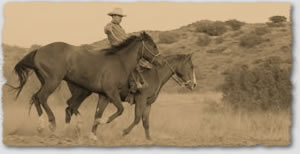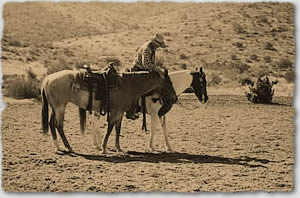Our framework will determine how we approach the horse at every level of training. A good framework will make us successful in communicating with our horse. A poor one will frustrate ourselves and the horse. So what is the good framework, what is the true path? No one can really tell us that but the horse. However if we look around we see many contemporary horsemen that excel with horses.
 No matter who you like the most: John Lyons, Buck Branhamnan, Martin Black, Ray Hunt, or Clinton Anderson; all understand the horse’s needs. Though their styles and skill’s may vary, the unifying aspect of all true horsemen is their understanding of how to communicate to a horse through consideration of how the horse feels and what it needs to be comfortable. My belief is that in order to communicate well with a horse I have to understand his needs so that he can understand what I want. From the horse’s perspective his needs (food, water, shelter, to feel comfortable) are paramount. My wants (ride him down the road, catch him, pet him) are not all that important. If I can’t pet my horse, no big deal. But, if my horse feels uncomfortable he might decide to jump the fence and hurt himself to get comfortable by getting away from me. He has no idea if I am going to eat him or pet him; therefore I have to meet his need to feel comfortable. If I don’t, I won’t get far with my want to pet him. To not get my want is disappointing to not have a need met is detrimental.
No matter who you like the most: John Lyons, Buck Branhamnan, Martin Black, Ray Hunt, or Clinton Anderson; all understand the horse’s needs. Though their styles and skill’s may vary, the unifying aspect of all true horsemen is their understanding of how to communicate to a horse through consideration of how the horse feels and what it needs to be comfortable. My belief is that in order to communicate well with a horse I have to understand his needs so that he can understand what I want. From the horse’s perspective his needs (food, water, shelter, to feel comfortable) are paramount. My wants (ride him down the road, catch him, pet him) are not all that important. If I can’t pet my horse, no big deal. But, if my horse feels uncomfortable he might decide to jump the fence and hurt himself to get comfortable by getting away from me. He has no idea if I am going to eat him or pet him; therefore I have to meet his need to feel comfortable. If I don’t, I won’t get far with my want to pet him. To not get my want is disappointing to not have a need met is detrimental.
Most horsemen will tell you that horses respond to pressure. Pressure can break down into two major groups, either it drives a horse or it directs a horse. This seems to be a pretty natural thing for horses to understand. If we can effectively drive and direct our horse we can be in a better area to help our horse understand what we are asking of it. Understanding and consideration are the foundation to any partnership, with a horse there is little difference.


